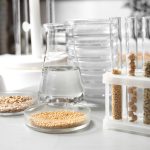SGS Seed and Crop News: May 2020
In this edition of SGS Seed and Crop Canada News:
- Hay and Silage Analysis for Improved Management
- Plant Tissue Testing for Immediate and Long-Term Gains
- Ask our Experts: What is the accurate procedure to sample crop tissue?
HAY AND SILAGE ANALYSIS FOR IMPROVED MANAGEMENT
Silage
With several months of feeding remaining on last year’s silage, confirming current nutrient levels are critical for milk production and efficient gain, with the additive benefit of insight into silage management. Choose our comprehensive CPM package! Analytical data is the first step to study and improve silage quality for the upcoming silage season.
Hay
After the first cut of forage has been harvested, there is a window of opportunity to collect samples for thorough testing which will help guide future nutrient management decisions:
- Soil testing will provide recommendations to meet the fertility needs of the forage crop, especially for potash, which has high removal rates.
- Manure testing will specifically measure available nutrient, allowing calculation of optimum rates of application, and in conjunction with a soil test will guide application to fields that are in the greatest need.
Get pricing for the CPM silage package, soil and manure testing at CA.SeedandCrop@sgs.com.
PLANT TISSUE TESTING FOR IMMEDIATE AND LONG-TERM GAINS
Although soil mineral nutrient testing is essential for planning, only a plant tissue diagnostic test demonstrates how efficiently the nutrients are being utilized by the crop. Tissue testing is often used to confirm a visual deficiency symptom, but can also be used as a monitoring tool:
- Discover ‘hidden hunger’, deficiencies not yet symptomatic
- Identify toxicities or excessive uptake
- Measure nutrient ratios (N:S, K:Mg)
- Assess impact of nutrient applications
- Trouble shoot growth problems
Inquire about submitting plant tissue for analysis at CA.SeedandCrop@sgs.com
ASK AN ANALYST: WHAT IS THE ACCURATE PROCEDURE TO SAMPLE CROP TISSUE?
When testing plant tissue, prioritize proper sampling techniques, collect a sufficient sample size and package to ensure viability. Here are pointers to assist:
- Minimum 200 grams of fresh material. Air drying is accepted.
- Collect multiple plants to build the representative sample.
- Early season: Collect the whole above ground plant material.
- Later season: Collect the most recent fully developed leaf (wheat flag leaf; corn ear leaf).
- Sample ‘healthy/productive’ plants vs ‘poorly developed/stunted/discolored’ plants for comparison. Include symptomatic tissue, but do not collect dead tissue.
- Package leaf tissue in paper, never in plastic, to allow for moisture transpiration





